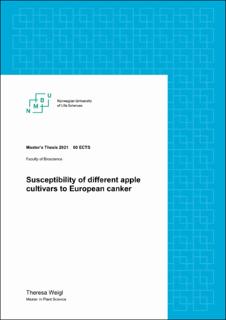| dc.contributor.advisor | Stensvand, Arne | |
| dc.contributor.advisor | Brurberg, May Bente | |
| dc.contributor.advisor | Børve, Jorunn | |
| dc.contributor.author | Weigl, Theresa | |
| dc.coverage.spatial | Norway | en_US |
| dc.date.accessioned | 2021-08-09T10:00:51Z | |
| dc.date.available | 2021-08-09T10:00:51Z | |
| dc.date.issued | 2021 | |
| dc.identifier.uri | https://hdl.handle.net/11250/2766964 | |
| dc.description.abstract | European canker, caused by Neonectria ditissima, is a severe economic problem for apple producers in northern Europe. The fungus can cause dieback in mature and young trees. Apple cultivars vary in their level of susceptibility to N. ditissima. However, detailed information regarding cultivar susceptibility of the main cultivars grown in Norway is still missing. The present thesis aimed to assess possible cultivar differences in canker development and evaluate the effect of wound type on canker development under field conditions in western Norway. | en_US |
| dc.language.iso | eng | en_US |
| dc.publisher | Norwegian University of Life Sciences, Ås | en_US |
| dc.rights | Attribution-NonCommercial-NoDerivatives 4.0 Internasjonal | * |
| dc.rights.uri | http://creativecommons.org/licenses/by-nc-nd/4.0/deed.no | * |
| dc.subject | European canker | en_US |
| dc.subject | Neonectria ditissima | en_US |
| dc.subject | apple cultivars | en_US |
| dc.title | Susceptibility of different apple cultivars to European canker | en_US |
| dc.type | Master thesis | en_US |
| dc.subject.nsi | VDP::Matematikk og Naturvitenskap: 400::Zoologiske og botaniske fag: 480 | en_US |
| dc.description.localcode | M-PV | en_US |

